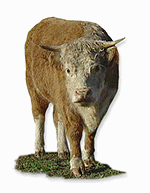Breed: Miniature Hereford
Temperament: docile
Cost: breeders $2000-$15,000, steers $200-$600
Recommended for: hobby farmers, small acreages
What meat-eater could resist a juicy T-bone? But what if you’ve been told to eat less red meat – half a T-bone just isn’t the same. Maybe a Miniature Hereford T-bone is the right size!
Miniature Herefords are just one type of cattle being developed in Australia to fill a niche created by smaller acreages often owned by people unfamiliar with traditional breeds such as Herefords.
Appearance
Miniature Herefords look just like smaller versions of traditional Herefords with rich red coats, and white face, belly and markings.
The ideal size for Miniature Herefords is around 1 metre (ie: 100cm) tall. Seamus, the young bull shown, is around 104cm tall but many Miniature Herefords are around 125cm or taller. Buyers would need to be careful to select animals in the lower height range of around 100-110cm tall.
Temperament
Owners say Miniature Herefords are easier to handle, mostly due to their smaller size and most are trained to be led. It should be remembered, however, that bulls should not be trusted, no matter what breed.
Health
They are said to mature by 14 months, while retaining the healthy outlook of their full-size cousins. Pink eye and skin cancer could be a problem, similar to that for most white-faced cattle breeds.
The Australian Miniature Hereford Cattle Association also checks the breed for achondroplasia, the gene which causes dwarfism (the condition whereby the body is of normal size but the legs are shortened and often deformed). "Miniature" means a true replica of the full-size Hereford, but smaller.
Breeding
Despite their attractive outlook there are only around 100 Miniature Herefords in Australia. A handful have been imported at considerable expense (up to $50,000), but more are being bred locally using embryos flushed from true Miniatures and implanted in (full-size) recipient cows, somewhat like a surrogate.
Space
Enthusiasts claim Miniatures have a more efficient stocking rate, that is, more are able to be sustained per hectare than full-size breeds, while being softer on the landscape as they are lighter and have smaller feet.
Uses
It’s estimated that a typical Miniature Hereford T-bone would be about a third the size of that provided by a full-grown Hereford. While few people could today afford to butcher a Miniature for the barbecue, in the long term the smaller cuts are seen as being attractive for the home and gourmet markets.
Further information
Australian Miniature Hereford Cattle Association
Joe Flint
Phone: (08) 8388 8632



